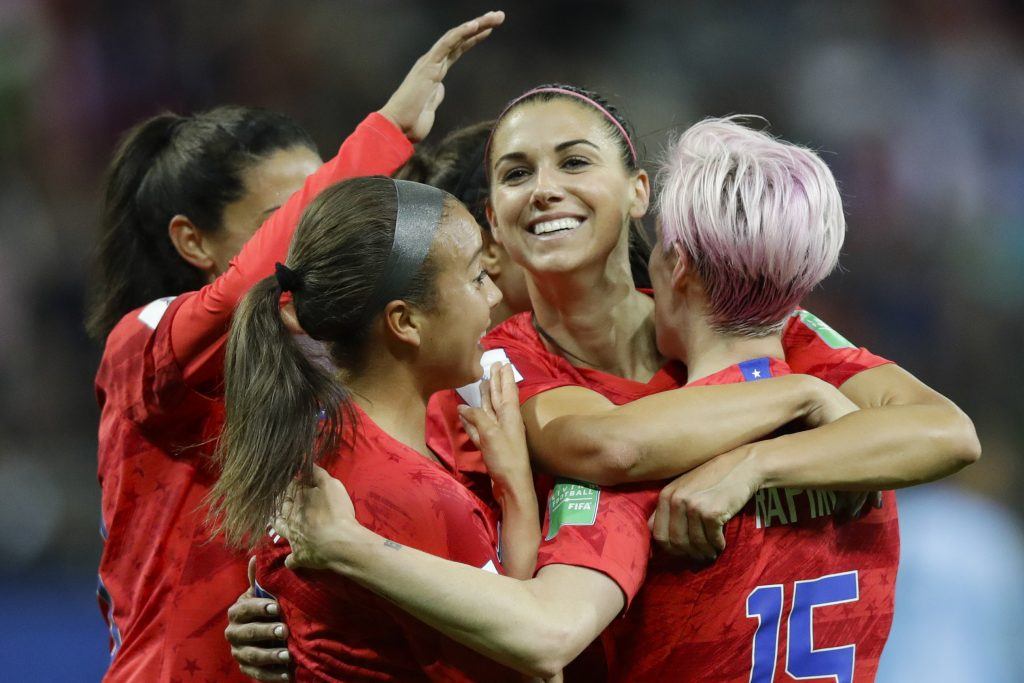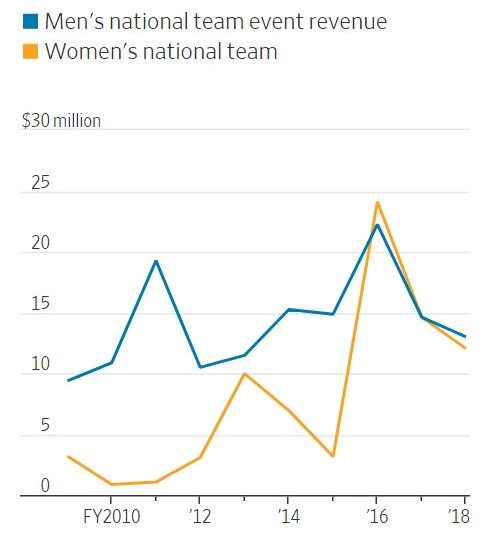The assertion that US Men’s soccer generates more revenue than the US Women’s team was recently debunked by the US Soccer Federation’s own numbers.

The pay gap between men and women in US soccer was understood to be purely economic. If the men generated more revenue, they deserved higher pay. And while that might have been true in the past, it hasn’t had merit since the U.S Women’s team brought home the World Cup in 2015.
As reported by the Wall Street Journal, the US Women’s team generated more event revenue than the men’s team between 2016-2018. According to US Soccer Federation’s audited financial statements, the US Women’s National Team generated $50.8 million to the men’s $49.9 million.
US Women Catching Up

Mind the Performance Gap
There is no mystery behind the numbers. The United States Women’s National Team (USWNT) is number one in FIFA’s Women’s World Rankings. The USWNT has won four Olympic gold medals and three World Cups. And they have just made it into the knockout rounds of this year’s World Cup.
In contrast, the US men’s team dropped from 24th place to 30th place in the most recent FIFA Men’s World Rankings. The men’s national team has never won a World Cup and failed to qualify for the tournament in 2018. And you’d have to go back to 1904 to find an Olympic medal for a US men’s soccer team.
In a nutshell, the US women have just won more in recent years. Performance is starting to drive soccer revenue. And revenue may finally start to drive pay.
Soccer Revenue Parity Could Lead to Pay Parity
While it seems like a small difference, soccer’s event revenue may have triggered the recent decision to mediate in the pending gender-discrimination lawsuit filed by the members of the US Women’s team. The suit alleged that US Soccer Federation has denied the women equal pay, promotion, training and travel accommodations. It also claimed that women are getting paid 38 percent of the what the men make per game in some cases
Arguably, soccer event revenue is only part of soccer’s economic puzzle. Marketing, broadcast rights and sponsorships also contribute to the Federation’s bottom line. But here it’s more difficult to split out the differences. The Federation generally bundles these sales, so the revenue is not separated by team.
Sponsors, however, don’t want to be lost in the bundle. The US Soccer Federation may be seen as late to the pay parity party. But the sponsors are showing up with gifts to demonstrate their support. For instance, the nutrition bar company Luna, has pledged $31,250 to each member of the women’s team. The amount makes up the shortfall between the bonus the US Soccer Federation pays the men’s team and the women’s team to qualify for the World Cup.
"We don't have balls.
But we know how to use them!"The @DFB_Frauen with a 🔥 campaign ahead of this summer's Women's World Cup. #FIFAWWC pic.twitter.com/IC1b9b2VHU
— DW Sports (@dw_sports) May 14, 2019
Sponsors Score Points with Viral Ads
The credit card company Visa announced that at least 50% of its soccer sponsorship money is earmarked for the women’s team and programs.  More than 800 women’s soccer-related ads and videos have been produced by companies for the Women’s World Cup. Visa is using the World Cup to air its “One Moment Can Change the Game” ad. Nike is airing its “Dream Further” ad.
The soccer-themed ad getting the most buzz, however, isn’t a US ad. But it could be. It’s a Twitter video sponsored by Commerzbank, featuring the German Women’s national team. When it comes to women’s soccer, the message stressing parity is universal.












The revenue graph DOES tell a story. For a very short period of time during a 9 year period, the women BARELY produced more revenue than the men. This was in spite of their disproportionate level of success. Reality…..the men maintain a greater ability to produce higher revenue [and did so during the last 9 years] than the women, simply because the men’s game is more marketable on the world stage. It’s a fact! The market dictates pay. Demand is what the market says it is. Any artificial manipulation of that economic reality leads to an unjust result. Yes, that’s right! An unjust result for the men if you take money from their coffers and give it to the women. Success doesn’t matter. Performance level doesn’t matter. MONEY/REVENUE IS ALL THAT MATTERS!! If you believe in some other measurement or standard, then you don’t believe in capitalism. In our capitalist society, the men have produced a lot more revenue during the last nine years. If you don’t believe in capitalism, you can move to a country and play for a team that is not backed by money earned within a capitalist marketplace. If you do believe in capitalism, you must acknowledge that you are not entitled to equal pay. Very simple. You can’t have it both ways.
That’s clearly a lie. The mens world cup generates billions compared to the millions women generate. Also the viewership is considerably higher. Having said that even if it were true. So what. I don’t see women complaining about the selective service gap.